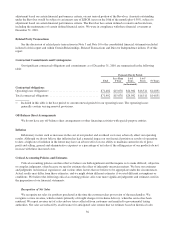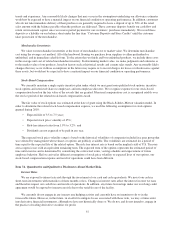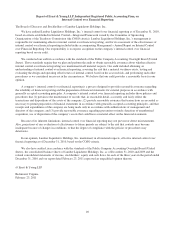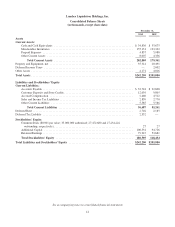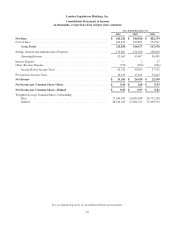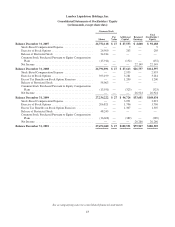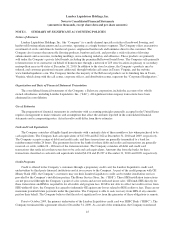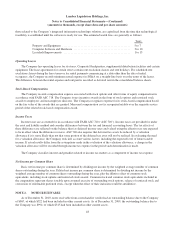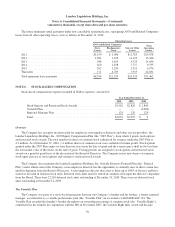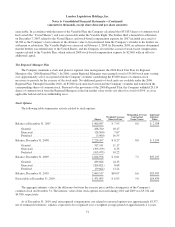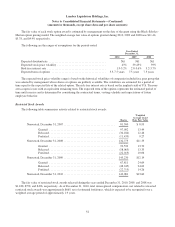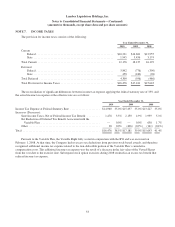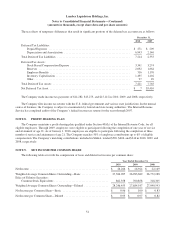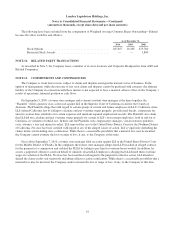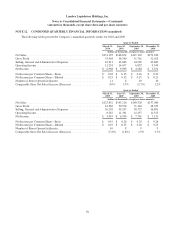Lumber Liquidators 2010 Annual Report Download - page 52
Download and view the complete annual report
Please find page 52 of the 2010 Lumber Liquidators annual report below. You can navigate through the pages in the report by either clicking on the pages listed below, or by using the keyword search tool below to find specific information within the annual report.Lumber Liquidators Holdings, Inc.
Notes to Consolidated Financial Statements—(Continued)
(amounts in thousands, except share data and per share amounts)
$1,500 of cash to HSBC as prepayment for certain fees, returns or other net credits. In December 2010, HSBC refunded $350
to the Company. The Company has included $700 and $500 of the remaining amount in other assets at December 31, 2010
and 2009, respectively, and $70 and $1,000 of the remaining amount in prepaid expenses at December 31, 2010 and 2009,
respectively.
A credit line is offered to the Company’s professional customers through the Lumber Liquidators Commercial Credit
Program. This commercial credit program is underwritten by a third party financial institution, generally with no recourse to
the Company.
Fair Value of Financial Instruments
The carrying amounts of financial instruments such as cash and cash equivalents, notes receivable, accounts payable and
other liabilities approximate fair value because of the short-term nature of these items. Of these financial instruments, the
cash equivalents are classified as Level 1 as defined in the Financial Accounting Standards Board (“FASB”) ASC 820 fair
value hierarchy.
Merchandise Inventories
The Company values merchandise inventories at the lower of cost or market value. Merchandise cost is determined
using the average cost method. All of the hardwood flooring purchased from vendors is either prefinished or unfinished, and
in immediate saleable form. The Company adds the finish to, and boxes, various species of unfinished product, to produce
certain proprietary products, primarily Bellawood, at its finishing facility. These finishing and boxing costs are included in
the average unit cost of related merchandise inventory. The Company maintains an inventory reserve for loss or
obsolescence, based on historical results and current sales trends. This reserve was $450 and $602 at December 31, 2010 and
2009, respectively.
Impairment of Long-Lived Assets
The Company evaluates potential impairment losses on long-lived assets used in operations when events and
circumstances indicate that the assets may be impaired, and the undiscounted cash flows estimated to be generated by those
assets are less than the carrying amounts of those assets. If impairment exists and the undiscounted cash flows estimated to
be generated by those assets are less than the carrying amount of those assets, an impairment loss is recorded based on the
difference between the carrying value and fair value of the assets. No impairment charges were recognized in 2010, 2009, or
2008.
Goodwill and Other Indefinite-Lived Intangibles
Other assets include $1,050 of goodwill and $800 for an indefinite-lived intangible asset for the phone number
1-800-HARDWOOD and related internet domain names. The Company evaluates these assets for impairment on an
annual basis, or whenever events or changes in circumstance indicate that the asset carrying value exceeds its fair value.
Based on the analysis performed, the Company has concluded that no impairment in the value of these assets has
occurred.
Self Insurance
The Company is self-insured for certain employee health benefit claims. The Company estimates a liability for
aggregate losses below stop-loss coverage limits based on estimates of the ultimate costs to be incurred to settle known
claims and claims not reported as of the balance sheet date. The estimated liability is not discounted and is based on a
number of assumptions and factors including historical trends, actuarial assumptions and economic conditions. This liability
could be affected if future occurrences and claims differ from these assumptions and historical trends. As of December 31,
46


